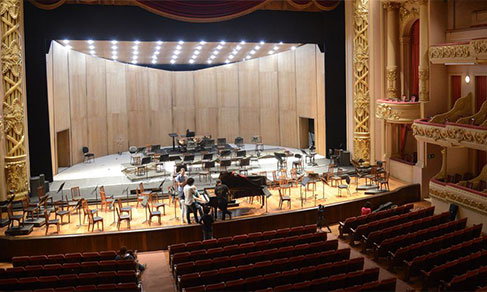Nossos serviços estão apresentando instabilidade no momento. Algumas informações podem não estar disponíveis.
SIIC - System of Cultural Information and Indicators
About - 2011-2022
The System of Cultural Information and Indicators - SIIC aims at developing a consistent and continuous database on the cultural sector and build indicators related to the topic, in order to foster studies, research and publications, providing governmental and private agencies with information for planning and decision-making and, the users in general, information for more in-depth analyses an sectoral studies.
With the release of this factsheet, the IBGE presents the results of the sixth edition of the SIIC, for the period 2011-2022, having as a guideline the Framework for Cultural Statistics (FCS) prepared by the United Nations Educational, Scientific and Cultural Organization (Unesco).
As in the previous edition, social and economic statistics from the IBGE and external records from public administration information systems were used in this investigation, which allowed us to characterize the population involved in cultural activities, update the scope of production of goods and services and the price index for measuring the cost of living associated with this sector, as well as identifying government and household expenditures with such activities in a period of great relevance to the cultural sector, especially in recent years, due to impacts and consequences of the COVID-19 pandemic, which started in 2020.
Besides updating and improving the information presented in previous editions, this publication presents some innovations, among which are statistics on leisure tourism, culture and nature, obtained from the Continuous National Household Sample Survey – Continuous PNAD 2021, and statistics about the existence of durable goods in the housing units, obtained from the Consumer Expenditure Survey - POF 2017-2018. Other statistics used come from the Survey of Basic Municipal Information - Munic 2021 and from the model for calculation of routes, distances and duration of travel and areas from the survey Areas of Influence of Cities - Regic 2018 to assess the conditions of access of the population to selected cultural facilities (museums, theaters, auditoriums and movie theaters) in Municipalities lacking these facilities. The evaluation of public expenditure concerning the cultural sector encompasses, as a complement, aspects of taxes that exceed Rouanet Law (Law no. 8,313, of Dec 23, 1991), dealt with in previous editions. It should be noted that some of the information sources used are employed for a short-term analysis of the sector, whereas others allow the delimitation of its structure, thus enabling comparisons over a longer period of time.
The factsheet is also available in print. The technical notes, released separately and accessible only in digital format, present methodological considerations which highlight the description and classification of economic activities related to culture and their correspondence with the National Classification of Economic Activities - CNAE 2.0, the main characteristics of the surveys used as sources of information, and the indicators selected to delimit this productive sector. The notes are complemented with a glossary that brings together the concepts considered relevant for understanding the results.
The IBGE portal on the Internet reproduces the printed volume and makes available the detailed table plan of the study, with disaggregation by different sections, thus allowing users to explore all this information from different perspectives.
Tables - 2011-2022
Formal activities (xlsx and ods)
Structural surveys in companies (xlsx and ods)
Public expenditure (xlsx and ods)
Cultural Price Index – IPCult (xlsx and ods) - updated on 7/30/2025
Household expenditure (xlsx and ods)
Employment in the cultural sector xlsx and ods)
Access to the Internet and to television and ownership of mobile phone for personal use (xlsx and ods)
Access to facilities and Aldir Blanc Law in municipalities (xlsx and ods)
Leisure, culture and nature tourism (xlsx and ods)
Table indexes (pdf)
Concepts and methods - 2011-2022
As informações a seguir descrevem os metadados estatísticos, que são o conjunto de conceitos, métodos e aspectos relacionados às estatísticas, e são informações necessárias para compreender as características e a qualidade das estatísticas e interpretá-las corretamente.
Informações Gerais
Objetivo
O Sistema de Informações e Indicadores Culturais 2011-2022 buscou traçar um panorama a partir de diversas dimensões da Cultura no Brasil. Segue o Marco Referencial para Estatísticas Culturais da UNESCO (2009). O recorte utilizado no SIIC incluiu setores econômicos relacionados à cultura, gastos públicos, ocupação em trabalhos formais e informais, variação de preços, acesso à tecnologia (TV e Internet), turismo cultural, inventário de bens no domicilio, acesso a equipamentos e à Lei Aldir Blanc nos municípios. Sob os limites das fontes utilizadas e do recorte proposto, mostrou variabilidade no tempo e no espaço, além de pontuar desigualdades sociais. A periodização dos indicadores é variável em função da fonte utilizada, com dados entre 2011 e 2022.Tipo de operação estatística
Sistema de indicadores sínteseTipo de dados
Registros administrativos, Dados de pesquisa por amostragem probabilística, Dados de cadastros, Indicadores, Outro tipo de dadosPeriodicidade de divulgação
EventualMetodologia
Técnica de coleta:
Não se aplicaTemas
Temas e subtemas
Estatísticas multidomínio, Cultura, recreação e esporteUnidades de informação
Unidade de investigação
Não se aplicaUnidade de análise
Não se aplica.Períodos de referência
Disseminação
Saiba mais
https://metadados.ibge.gov.br/consulta/estatisticos/operacoes-estatisticas/BRPublications - 2011-2022
Sistema de informações e indicadores culturais : 2011-2022 / IBGE, Coordenação de População e Indicadores Sociais
Material type: Book
Year: 2023
Description
The SIIC started in 2004 based on a partnership established between the IBGE and the Ministry of Culture in 2004. It is aimed at the development of a consistent and continuous basis for information on the cultural sector and at the construction of cultural indicators in order to foster studies, surveys and publications, thus providing governmental and private bodies with material for proper planning and decision making processes, and users in general with information needed for more detailed sector analyses.
As a result of the partnership, the IBGE has conducted studies on the production (supply) of goods and services, household and government expenses (demand) and characteristics of the population employed in the cultural sector, considering the statistics produced by the Institute.
The support material for this publication encompasses a group of tables the coefficients of variation associated with the released estimates
Technical Information
Methodological considerations on this survey can be obtained in the Technical notes chapter of its results publication.
News and Releases
From 2011 to 2022, cultural sector receives more companies, but reduces its participation in the economy
In one decade, the number of companies in the cultural sector increased by 3.1%, and reached 387.5 thousand...
01/12/2023
2009-2020 SIIC: cultural sector employed 4.8 million workers in 2020
The cultural sector employed 4.8 million persons in 2020, according to the Continuous PNAD. The figure...
08/12/2021
With pandemic, cultural sector loses 11.2% of employed persons in 2020
The pandemic brought a severe impact on the cultural sector in 2020. Compared to the previous year, it...
08/12/2021
Brazil has almost 40% of the population in municipalities without cinemas
Going to the movies is still a very uncommon activity for many Brazilians. In 2018, 39.9% of the population...
05/12/2019
Errata
Replacement of publication System of Cultural Information and Indicators - SIIC 2011-2022 / IBGE
Published date: 30/07/2025
Description:
Due to an improper duplication of values in the consolidation of indicators at the Major Regions level, errors in percentages shown on pages 7 and 8 were pinpointed.. Tables 4.1 and 4.2 of the table plan on the Internet showed errors as well. Such occurrences were concentrated in the Central-West and North regions.Actions: An errata has been included in the Report and tables replaced.







